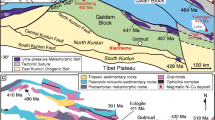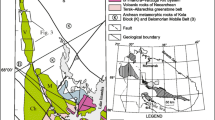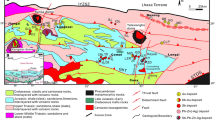Abstract
Previous geochemical data for the Jinchuan Ni-Cu-(platinum-group elements, PGE) deposit, the single largest magmatic sulfide deposit in the world, are derived primarily from the upper parts of the deposit. This paper reports new PGE and S-Hf-Sr-Nd isotope data for the lower parts of the deposit that have become accessible for sampling by ongoing underground mining activity. New PGE data from this study, together with previous results, indicate that PGE tenors in the bulk sulfide ores of the deposit increase eastward, except for two fault-offset ore zones which occur together within the western part of the deposit. Generally, these two ore zones show depletions in IPGE (Ir, Ru, Rh) but not in PPGE (Pt, Pd) and Cu, and more fractionated olivine and Cr-spinel compositions than the rest of the deposit. These differences can be explained by a more evolved parental magma for the IPGE-depleted ore zones. The eastward increase of PGE tenors in the rest of the deposit can be explained by upgrading of preexisting sulfide liquid in a subhorizontal conduit by a new surge of magma moving through the conduit from west to east, which took place before the formation of the IPGE-depleted ore zones. The Jinchuan ultramafic rocks are characterized by elevated initial 87Sr/86Sr ratios from 0.7077 to 0.7093, negative ε Nd values from −9.2 to −10.5, and zircon ε Hf values from −4 to −7. These data indicate up to 20 % of crustal contamination in the Jinchuan magma. Four of nine multiple sulfur isotope analyses for the Jinchuan deposit show anomalous ∆33S values varying from 0.12 to 2.67 ‰. These results, together with elevated δ34S values (>2 ‰) for some of the samples analyzed previously by other researchers, indicate the involvement of external sulfur from Archean and Proterozoic sedimentary rocks. Modeling results based on our olivine data and magma compositions estimated previously by other researchers indicate that fractional crystallization did not play a major role in triggering sulfide saturation in the Jinchuan magma and that the parental magma experienced previous sulfide segregation during ascent or in staging chambers.














Similar content being viewed by others
References
Asimow PD, Ghiorso MS (1998) Algorithmic modifications extending MELTS to calculate subsolidus phase relations. Am Mineral 83:1127–1132
Barnes S-J, Lightfoot PC (2005) Formation of magmatic nickel–sulfide ore deposits and processes affecting their copper and platinum-group element contents. In: Hedenquist JW, Thompson JFH, Goldfard RJ, Richards JP (eds) Economic geology 100th Anniversary Volume, pp 179–213
Barnes SJ, Tang ZL (1999) Chrome spinels from the Jinchuan Ni–Cu sulfide deposit, Gansu province, People’s Republic of China. Econ Geol 94:343–356
Barnes SJ, Godel B, Gürer D, Brenan JM, Robertson J, Paterson D (2013) Sulfide–olivine Fe–Ni exchange and the origin of anomalously Ni rich magmatic sulfides. Econ Geol 108:1971–1982
Brenan JM (2003) Effects of fO2, fS2, temperature, and melt composition on Fe–Ni exchange between olivine and sulfide liquid: implications for natural olivine–sulfide assemblages. Geochim Cosmochim Acta 67:2663–2681
Brenan JM, McDonough WF, Dalpe C (2003) Experimental constraints on the partitioning of rhenium and some platinum-group elements between olivine and silicate melt. Earth Planet Sci Lett 212:135–150
Brenan JM, Finnigan CF, McDonough WF, Homolova V (2012) Experimental constraints on the partitioning of Ru, Rh, Ir, Pt and Pd between chromite and silicate melt: the importance of ferric iron. Chem Geol 302–303:16–32
Campbell IH, Naldrett AJ (1979) The influence of silicate: sulfide ratios on the geochemistry of magmatic sulfides. Econ Geol 74:1503–1506
Chai G, Naldrett AJ (1992a) The Jinchuan ultramafic intrusion: cumulate of a high-MgO basaltic magma. J Petrol 33:277–303
Chai G, Naldrett AJ (1992b) Characteristics of Ni–Cu–PGE mineralization and genesis of the Jinchuan deposit, northwest China. Econ Geol 87:1475–1495
Chen LM, Song XY, Danyushevsky LV, Xiao JF, Li SB, Guan JX (2009) Correlation between Ni and MgO contents of olivine in segment I of the Jinchuan intrusion, NW China, and its geological implication. Acta Petrol Sin 25:3369–3378 (in Chinese with English abstract)
Chen L-M, Song X-Y, Keays RR, Tian Y-L, Wang Y-S, Deng Y-F, Xiao J-F (2013) Segregation and fractionation of magmatic Ni-Cu-PGE sulfides in the western Jinchuan intrusion, northwestern China: insights from platinum group element geochemistry. Econ Geol 108:1793–1811
de Waal SA, Xu ZH, Li C, Mouri H (2004) Emplacement of viscous mushes in the Jinchuan ultramafic intrusion, western China. Can Mineral 42:371–392
Ding X, Ripley EM, Shirey SB, Li C (2012) Os, Nd, O and S isotope constraints on country rock contamination in the conduit-related Eagle Cu–Ni–(PGE) deposit, Midcontinent Rift System, Upper Michigan. Geochim Cosmochim Acta 89:10–30
Duan J, Qian Z, Jiao J, Lu H, Feng Y (2015a) Genesis of Xijing intrusion from Longshoushan terrane and the tectonic significance. J Jilin Univ (Earth Sci Ed) 45:832–846 (in Chinese with English abstract)
Duan J, Li C, Qian Z, Jiao J (2015b) Geochronological and geochemical constraints on the petrogenesis and tectonic significance of mafic dykes in southern Alxa, North China Craton. J Asian Earth Sci 111:244–253
Farquhar J, Wing BA (2003) Multiple sulfur isotopes and the evolution of the atmosphere. Earth Planet Sci Lett 213:1–13
Fiorentini ML, Barnes SJ, Lesher CM, Heggie GJ, Keays RR, Burnham (2010) Platinum group element geochemistry of mineralized and nonmineralized komatiites and basalts. Econ Geol 105:795–823
Fiorentini ML, Beresford SW, Barley ME, Duuring P, Bekker A, Rosengren N, Cas R, Hronsky J (2012) District to camp controls on the genesis of komatiite-hosted nickel sulfide deposits, Agnew-Wiluna greenstone belt, Western Australia: insights from the multiple sulfur isotopes. Econ Geol 107:781–796
Geng Y-S, Wang X-S, Shen Q-H, Wu C-M (2006) Redefinition of the Alxa Group–complex (Precambrian metamorphic basement) in the Alxa area, Inner Mongolia. Geol China 33:138–145 (in Chinese with English abstract)
Ghiorso MS, Sack RO (1995) Chemical mass transfer in magmatic processes IV. A revised and internally consistent thermodynamic model for the interpolation and extrapolation of liquid–solid equilibria in magmatic systems at elevated temperatures and pressures. Contrib Mineral Petrol 119:197–212
Ghiorso MS, Hirschmann MM, Reiner PW, Kress VC (2002) The pMELTS: a revision of MELTS for improved calculation of phase relations and major element partitioning related to partial melting of the mantle to 3 GPa. Geochem Geophys Geosyst. doi:10.1029/2001GC000217
Gong JH, Zhang JX, Yu SY, Li HK, Hou KJ (2012) Ca. 2.5 Ga TTG rocks in the western Alxa Block and their implications. Chin Sci Bull 57:4064–4076
Herzberg C, Asimow PD (2015) PRIMELT3 MEGA.XLSM software for primary magma calculation: peridotite primary magma MgO contents from the liquidus to the solidus. Geochem Geophys Geosyst. doi:10.1002/2014GC005631
Hou KJ, Li YH, Zou TR, Qu XM, Shi YR, Xie GQ (2007) Laser ablation–MC–ICP–MS technique for Hf isotope microanalysis of zircon and its geological applications. Acta Petrol Sin 23:2595–2604 (in Chinese with English abstract)
Jiao J-G, Liu H, Duan J, Lu H, Luo D-Z, Qi D (2014) Hf isotope geochemical characteristics and magma sources in Jinchuan Cu–Ni sulfide deposit. J Earth Sci Environ 36:58–67
Johnston DT (2012) Multiple sulfur isotopes and the evolution of earth’s surface sulfur cycle. Earth Sci Rev 106:161–183
Labidi J, Cartigny P, Moreira M (2013) Non-chondritic sulphur isotope composition of the terrestrial mantle. Nature 501:208–211
Labidi J, Cartigny P, Hamelin C, Moreira M, Dosso L (2014) Sulfur isotope budget (32S, 33S, 34S and 36S) in Pacific-Antarctic ridge basalts: a record of mantle source heterogeneity and hydrothermal sulfide assimilation. Geochim Cosmochim Acta 133:47–67
Lehmann J, Arndt N, Windley B, Zhou M-F, Wang CY, Harris C (2007) Field relationships and geochemical constraints on the emplacement of the Jinchuan intrusion and its Ni–Cu–PGE sulfide deposit, Gansu, China. Econ Geol 102:75–94
Li C, Naldrett AJ (1994) A numerical model for the compositional variation of Sudbury sulfide ores and its application to exploration. Econ Geol 89:1599–1607
Li C, Naldrett AJ (1999) Geology and petrology of the Voisey’s Bay intrusion: reaction of olivine with sulfide and silicate liquids. Lithos 47:1–31
Li C, Ripley EM (2009) Sulfur contents at sulfide-liquid or anhydrite saturation in silicate melts: empirical equations and example applications. Econ Geol 104:405–412
Li C, Ripley EM (2010) The relative effects of composition and temperature on olivine–liquid Ni partitioning: statistical deconvolution and implications for petrologic modeling. Chem Geol 275:99–104
Li C, Ripley EM (2011) The giant Jinchuan Ni–Cu–(PGE) deposit: tectonic setting, magma evolution, ore genesis and exploration implications. Rev Econ Geol 17:163–180
Li C, Barnes S-J, Makovicky E, Rose-Hassen J, Makivicky M (1996) Partitioning of Ni, Cu, Ir, Rh, Pt and Pd between monosulfide solid solution and sulfide liquid: effects of temperature and composition. Geochim Cosmochim Acta 60:1231–1238
Li C, Maier WD, De Waal SA (2001) Magmatic Ni–Cu versus PGE deposits: contrasting genetic controls and exploration implications. S Afr J Geol 104:309–318
Li C, Xu Z, De Waal SA, Ripley EM, Maier WD (2004) Compositional variations of olivine from the Jinchuan Ni–Cu sulfide deposit, western China: implications for ore genesis. Mineral Deposita 39:159–172
Li XH, Su L, Chung S-L, Li ZX, Liu Y, Song B, Liu DY (2005) Formation of the Jinchuan ultramafic intrusion and the world’s third largest Ni–Cu sulfide deposit: associated with the ∼825 Ma south China mantle plume? Geochem Geophys Geosyst. doi:10.1029/2005GC001006
Li C, Naldrett AJ, Ripley EM (2007) Controls on the Fo and Ni contents of olivine in sulfide-bearing mafic/ultramafic intrusions: principles, modeling, and examples from Voisey’s Bay. Earth Sci Front 14:177–183
Li C, Tao Y, Qi L, Ripley EM (2012) Controls on PGE fractionation in the Emeishan picrites and basalts: constraints from integrated lithophile-siderophile elements and Sr–Nd isotopes. Geochim Cosmochim Acta 2012:12–32
Lightfoot PC, Keays RR (2005) Siderophile and chalcophile metal variations in flood basalts from the Siberian Trap, Noril’sk Region: implications for the origin of the Ni–Cu–PGE sulfide ores. Econ Geol 100:439–462
Morel MLA, Nebel O, Nebel-Jacobsen YJ, Miller JS, Vroon PZ (2008) Hafnium isotope characterization of the GJ–1 zircon reference material by solution and laser-ablation MC–ICPMS. Chem Geol 255:231–235
Mungall JE, Brenan JM (2014) Partitioning of platinum-group elements and Au between sulfide liquid and basalt and the origins of mantle-crust fractionation of the chalcophile elements. Geochim Cosmochim Acta 125:265–289
Naldrett AJ (2011) Fundamentals of magmatic sulfide deposits. Rev Econ Geol 17:1–50
Naldrett AJ, Duke JM (1980) Platinum metals in magmatic sulfide ores. Science 208:1417–1424
Palme H, O’Neill HSC (2014) Cosmochemical estimates of mantle composition. In: Carlson RW (ed) Treatise on geochemistry, vol 3, 2nd edn, The mantle and core. Elsevier–Pergamon, Oxford, pp 1–39
Prichard HM, Knight RD, Fisher PC, McDonald I, Zhou M-F, Wang CY (2013) Distribution of platinum-group elements in magmatic and altered ores in the Jinchuan intrusion, China: an example of selenium remobilization by postmagmatic fluids. Mineral Deposita 48:767–786
Ripley EM, Li C (2007) Applications of stable and radiogenic isotopes to magmatic Cu–Ni–PGE deposits: examples and cautions. Earth Sci Front 14:124–132
Ripley EM, Li C (2013) Sulfide saturation in mafic magmas: is external sulfur required for magmatic Ni–Cu–(PGE) ore genesis? Econ Geol 108:45–58
Ripley EM, Sarkar A, Li C (2005) Mineralogic and stable isotope studies of hydrothermal alteration at the Jinchuan Ni–Cu deposit, China. Econ Geol 100:1349–1361
Rudnick RL, Gao S et al (2003) Composition of the continental crust. In: Treatise on geochemistry, vol 3, The crust. Elsevier, Amsterdam, pp 1–64
SGU (the Sixth Geological Unit of the Geological Survey of Gansu Province) (1984) Geology of the Baijiaozuizi Cu-Ni sulfide deposit. Geological Publishing House, Beijing, p 225 (in Chinese)
Song X-Y, Zhou M-F, Wang CY, Qi L, Zhang C-J (2006) Role of crustal contamination in the formation of the Jinchuan Ni–Cu–(PGE) sulfide deposit, NW China. Int Geol Rev 48:1113–1132
Song X-Y, Keays RR, Zhou M-F, Qi L, Ihlenfeld C, Xiao J-F (2009) Siderophile and chalcophile elemental constraints on the origin of the Jinchuan Ni–Cu–(PGE) sulfide deposit, NW China. Geochim Cosmochim Acta 73:404–424
Song X-Y, Danyushevsky LV, Keays RR, Chen L-M, Tian Y-L, Xiao J-F (2012) Structural, lithological, and geochemical constraints on the dynamic magma conduit system related to the Jinchuan Ni–Cu sulfide deposit, NW China. Mineral Deposita 47:277–297
Song S, Niu Y, Su L, Xia X (2013) Tectonics of the North Qilian orogen, NW China. Gondwana Res 23:1378–1401
Su SG, Li C, Zhou M-F, Ripley EM, Qi L (2008) Controls on variations of platinum-group element concentrations in the sulfide ores of the Jinchuan Ni–Cu deposit, western China. Mineral Deposita 43:609–626
Sun S-S, McDonough WF (1989) Chemical and isotopic systematics in ocean basalt: implication for mantle composition and processes. In: Saunders AD, Norry MJ (eds) Magmatism in the ocean basins. Geological Society, London Special Publication 42:313–345
Sun Y, Sun M, Gong A (2000) Pre-concentration of platinum group elements with about 2.5 g nickel sulfide button. Chin J Anal Chem 8:1010–1012 (in Chinese)
Sun Y, Chu Z, Sun M, Xia X (2009) An improved Fe–Ni sulfide fire assay method for determination of Re, platinum group elements, and Os isotopic ratios by inductively coupled plasma- and negative thermal ionization-mass spectrometry. Appl Spectrosc 63:1232–1237
Tang ZL (1990) Mineralization model of the Jinchuan sulfide Cu–Ni deposit. Geoscience 4:55–64 (in Chinese)
Tang ZL (1993) Genetic models of the Jinchuan nickel–copper deposit. In: Kirkham RV, Sinclair WD, Thorpe RI, Duke JM (eds) Mineral deposit modeling. Geological Association of Canada Special Paper 40:389–401
Tang ZL, Li WY (1995) The metallogenetic model and geological characteristics of the Jinchuan Pt-bearing Ni–Cu sulfide deposit. Geological Publishing House, Beijing, p 209 (in Chinese)
Tang ZL, Yang J, Xu S, Li W (1992) Sm–Nd dating of the Jinchuan ultramafic rock body, Gansu. Chin Sci Bull 37:1988–1991 (in Chinese)
Tang ZL, Song X-Y, Su S (2009) Ni–Cu deposits related to high Mg basaltic magma, Jinchuan, western China. In: Li C, Ripley EM (eds) New developments in magmatic Ni-Cu and PGE deposits. Geological Publishing House, Beijing, pp 121–140
Tang Q, Li C, Zhang M, Ripley EM, Wang Q (2014) Detrital zircon constraint on the timing of amalgamation between Alxa and Ordos, with exploration implications for Jinchuan-type Ni–Cu deposit in China. Precambrian Res 255:748–755
Tonnelier NJ (2010) Geology and genesis of the Jinchuan Ni–Cu–(PGE) deposit, China. Unpublished PhD thesis. Laurentian University, Sudbury, p 192
Wu F-Y, Yang YH, Xie LW, Yang J-H, Xu P (2006) Hf isotopic compositions of the standard zircons and baddeleyites used in U–Pb geochronology. Chem Geol 234:105–126
Yang G, Du AD, Lu JR, Qu WJ, Chen JF (2005) Re–Os dating of the massive sulfide ores from the Jinchuan Ni–Cu–PGE deposit by ICPMS. Sci China Ser D Earth Sci 48:1672–1677 (in Chinese with English abstract)
Yang S, Qu W, Tian Y, Chen J, Yang G, Du A (2008) Origin of the inconsistent apparent Re–Os ages of the Jinchuan Ni–Cu sulfide ore deposit, China: post-segregation diffusion of Os. Chem Geol 247:401–418
Zhang Z, Du A, Tan S, Lu J, Wang J, Yang G (2004) Age of the Jinchuan copper-nickel deposit and isotopic geochemical feature of its source. Acta Geol Sin 78:359–365 (in Chinese with English abstract)
Zhang M, Kamo SL, Li C, Hu P, Ripley EM (2010) Precise U–Pb zircon-baddeleyite age of the Jinchuan sulfide ore-bearing ultramafic intrusion, western China. Mineral Deposita 45:3–9
Zong C-L, Yuan H-L, Dai M-N (2012) A feasibility study on chemical separation of Pb, Sr and Nd from the same single dissolution of geological sample. Rock and Mineral Analysis 31:945–949
Acknowledgments
This study was financially supported by the National Science Foundation of China (41372101, 41072058), China Geological Survey (12120114044401, 1212011085061), Special Funds for Public Welfare Project (200911007), and Chang’an University (2013G2273009, 310826151138). We thank Yaling Gao, Hao Lu, and Yushan Wang for assistance in field work and Anne Ayre and Benjamin Underwood for assistance in multiple S isotope analysis. This paper was written during Jun Duan’s visit to Indiana University which was financially supported by the China Scholarship Council (201306560011). Constructive reviews from Nicholas Arndt and Marco Fiorentini are greatly appreciated.
Author information
Authors and Affiliations
Corresponding author
Additional information
Editorial handling: M. Fiorentini
Rights and permissions
About this article
Cite this article
Duan, J., Li, C., Qian, Z. et al. Multiple S isotopes, zircon Hf isotopes, whole-rock Sr-Nd isotopes, and spatial variations of PGE tenors in the Jinchuan Ni-Cu-PGE deposit, NW China. Miner Deposita 51, 557–574 (2016). https://doi.org/10.1007/s00126-015-0626-8
Received:
Accepted:
Published:
Issue Date:
DOI: https://doi.org/10.1007/s00126-015-0626-8




